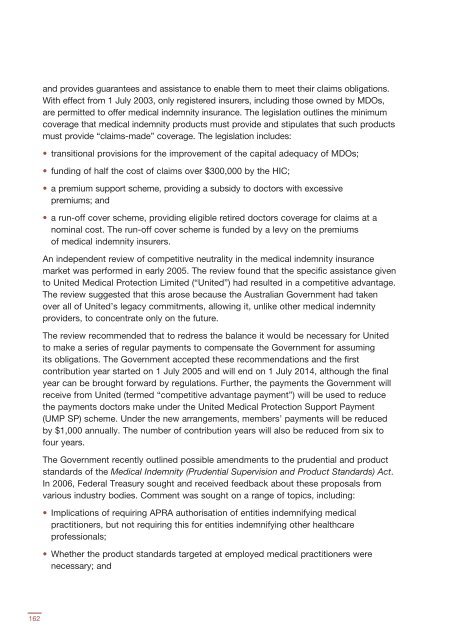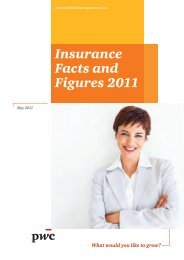Insurance facts and figures 2007 - PwC
Insurance facts and figures 2007 - PwC
Insurance facts and figures 2007 - PwC
Create successful ePaper yourself
Turn your PDF publications into a flip-book with our unique Google optimized e-Paper software.
<strong>and</strong> provides guarantees <strong>and</strong> assistance to enable them to meet their claims obligations.<br />
With effect from 1 July 2003, only registered insurers, including those owned by MDOs,<br />
are permitted to offer medical indemnity insurance. The legislation outlines the minimum<br />
coverage that medical indemnity products must provide <strong>and</strong> stipulates that such products<br />
must provide “claims-made” coverage. The legislation includes:<br />
• transitional provisions for the improvement of the capital adequacy of MDOs;<br />
• funding of half the cost of claims over $300,000 by the HIC;<br />
• a premium support scheme, providing a subsidy to doctors with excessive<br />
premiums; <strong>and</strong><br />
• a run-off cover scheme, providing eligible retired doctors coverage for claims at a<br />
nominal cost. The run-off cover scheme is funded by a levy on the premiums<br />
of medical indemnity insurers.<br />
An independent review of competitive neutrality in the medical indemnity insurance<br />
market was performed in early 2005. The review found that the specific assistance given<br />
to United Medical Protection Limited (“United”) had resulted in a competitive advantage.<br />
The review suggested that this arose because the Australian Government had taken<br />
over all of United’s legacy commitments, allowing it, unlike other medical indemnity<br />
providers, to concentrate only on the future.<br />
The review recommended that to redress the balance it would be necessary for United<br />
to make a series of regular payments to compensate the Government for assuming<br />
its obligations. The Government accepted these recommendations <strong>and</strong> the first<br />
contribution year started on 1 July 2005 <strong>and</strong> will end on 1 July 2014, although the final<br />
year can be brought forward by regulations. Further, the payments the Government will<br />
receive from United (termed “competitive advantage payment”) will be used to reduce<br />
the payments doctors make under the United Medical Protection Support Payment<br />
(UMP SP) scheme. Under the new arrangements, members’ payments will be reduced<br />
by $1,000 annually. The number of contribution years will also be reduced from six to<br />
four years.<br />
The Government recently outlined possible amendments to the prudential <strong>and</strong> product<br />
st<strong>and</strong>ards of the Medical Indemnity (Prudential Supervision <strong>and</strong> Product St<strong>and</strong>ards) Act.<br />
In 2006, Federal Treasury sought <strong>and</strong> received feedback about these proposals from<br />
various industry bodies. Comment was sought on a range of topics, including:<br />
• Implications of requiring APRA authorisation of entities indemnifying medical<br />
practitioners, but not requiring this for entities indemnifying other healthcare<br />
professionals;<br />
• Whether the product st<strong>and</strong>ards targeted at employed medical practitioners were<br />
necessary; <strong>and</strong><br />
162
















